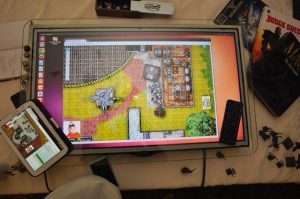Virtual tabletop games present Cthulhu maps that let players access another dimensional space. Your living room becomes your current location before the next instant shifts your perspective to another realm. You will view a warped map of Arkham the moment after which displays streets that appear to form their own entangled pathways. A map of R’lyeh would leave anyone with a splitting headache because of its disturbing geometric patterns. The experience will lead you on a ferocious trip no matter which direction you choose.

These maps aren’t just backgrounds. The cartography serves simultaneously as main characters of the world which they depict. A crumbling mansion functions as much more than a setting because it contains strange mysteries that render it a puzzle box of secrets. Fog covering the harbor serves as more than window dressing since it represents a dangerous operational hazard. Each shadow and every corner and additional lighting creates its unique tale in this environment. But if fortune favors you then the events in these maps will not become part of your narrative. Not yet, anyway.
Through virtual tabletop systems maps achieve an even higher level of capability. Interactivity emerges through bloodstain examination and library investigation and hidden passage detection by way of click commands. From your fingertip the horror unfolds directly before your eyes since you maintain ultimate control. And the actors. And probably the first victim.
Cthulhu maps produce their stunning aesthetic quality because they feature elements of surprise. Every new turn of events creates unknown possibilities before you. A cultist’s altar? A portal to another dimension? Or just a really creepy coat rack? The possibilities are endless. And terrifying.
Realistically speaking every map cannot achieve genius status. A few of these scenarios become uninteresting to your players through their basic nature or design. Several players become overburdened by the excessive details present in such Cthulhu maps. You must discover the ideal level of detail. Provide enough detail for them to envision the area but refrain from completely revealing all secrets. What scares players most often lies in the areas they cannot perceive with their eyes.
The production design elements of lighting along with sound development determine whether a map succeeds or fails. You should dim your lighting because the otherwise empty hallway transforms into an open death path against the darkness. When you introduce distant background noises the effect on your players will be intense shadow-filled jumping. It’s all about atmosphere. A Cthulhu game succeeds or fails based entirely on its atmospheric success.
The matter of dimensional size remains to be determined. How big should the map be? A space that is too confining feels uncomfortable to players. Such a big size reduces the intended effect. The key is balance. Keep your exploration space open for the players yet maintain constant tension throughout the adventure. The greatest power behind horror emerges from areas without escape opportunities.
References and tags up the character immersion experience significantly. The way a story sells itself depends on minor details throughout the setting which include symbols and blood stains. And don’t forget the monsters. A strategically placed tentacle will transform an ordinary examination session into out-of-control panic.
The requirement for creating nightmare-inducing maps does not extend to all situations in RPG design. Making the atmosphere less stressful through humor works exceptionally well at times. One of the cultists accidentally falls because he cannot master his own religious garments. An offbeat creepy being instead of a genuine horrifying creature exists in this adventure. Every detail helps keep the players off balance throughout your game.
